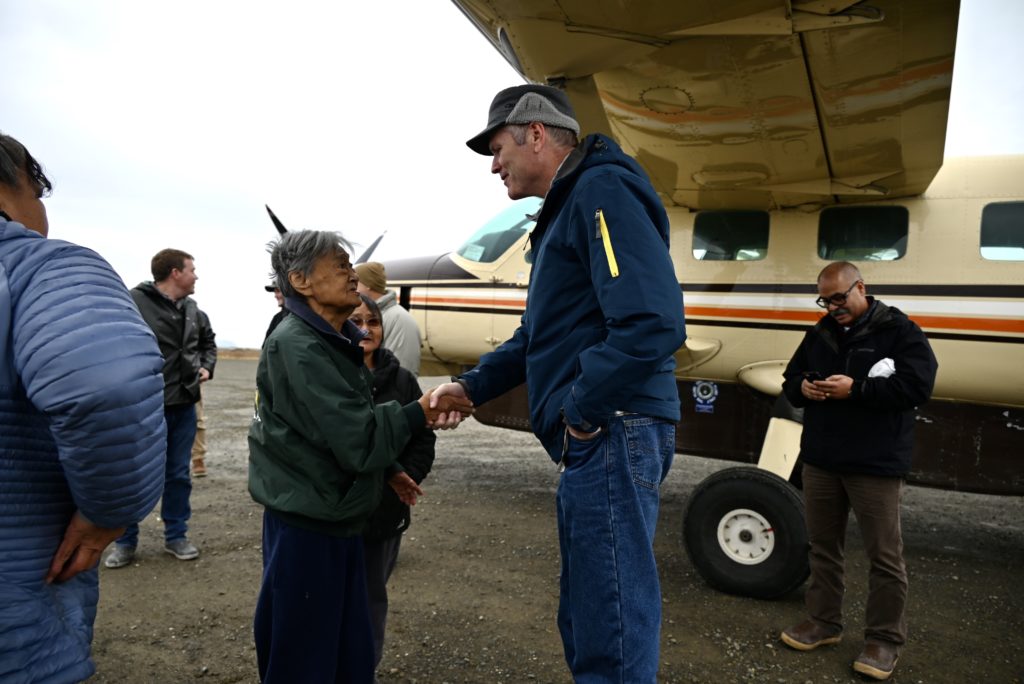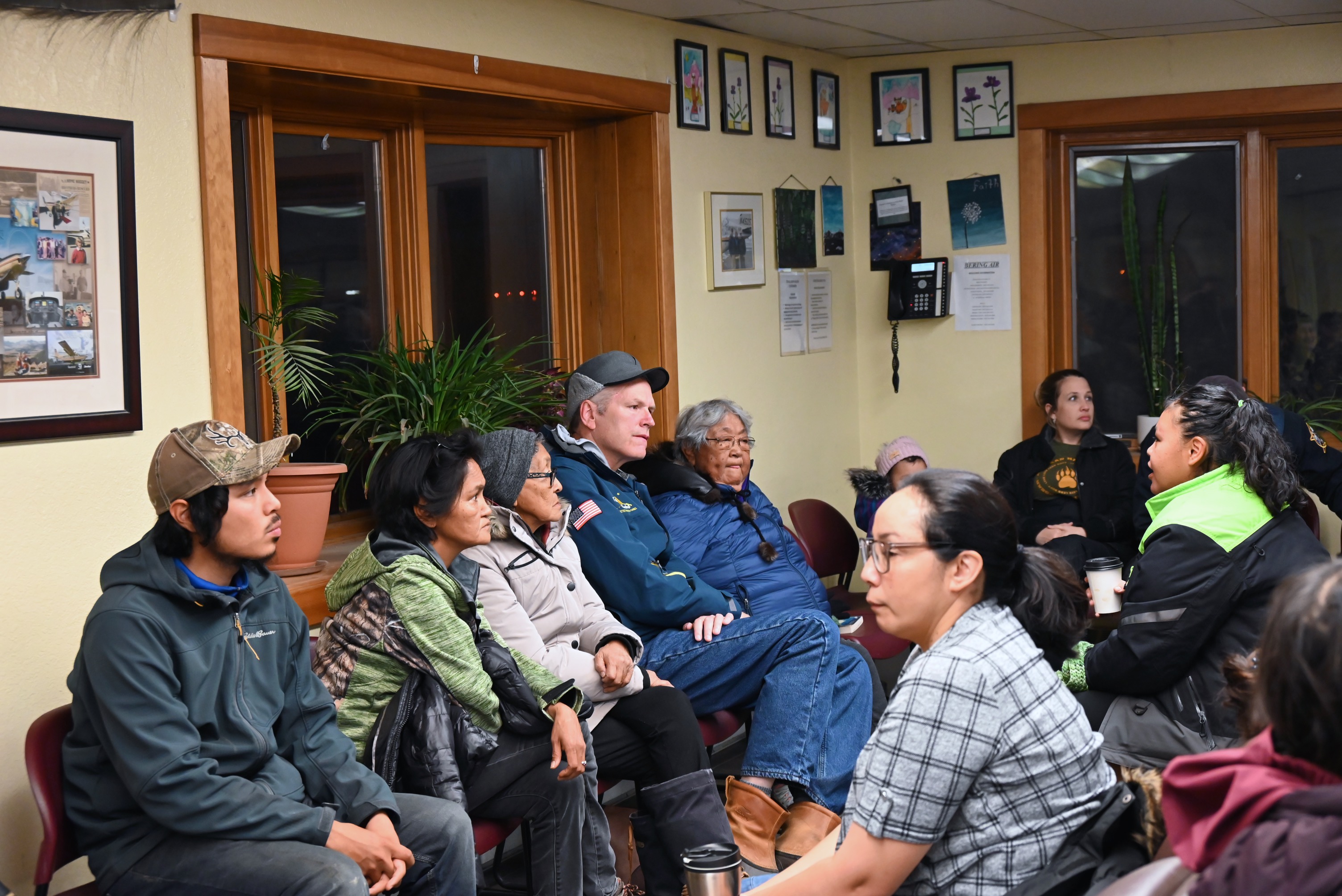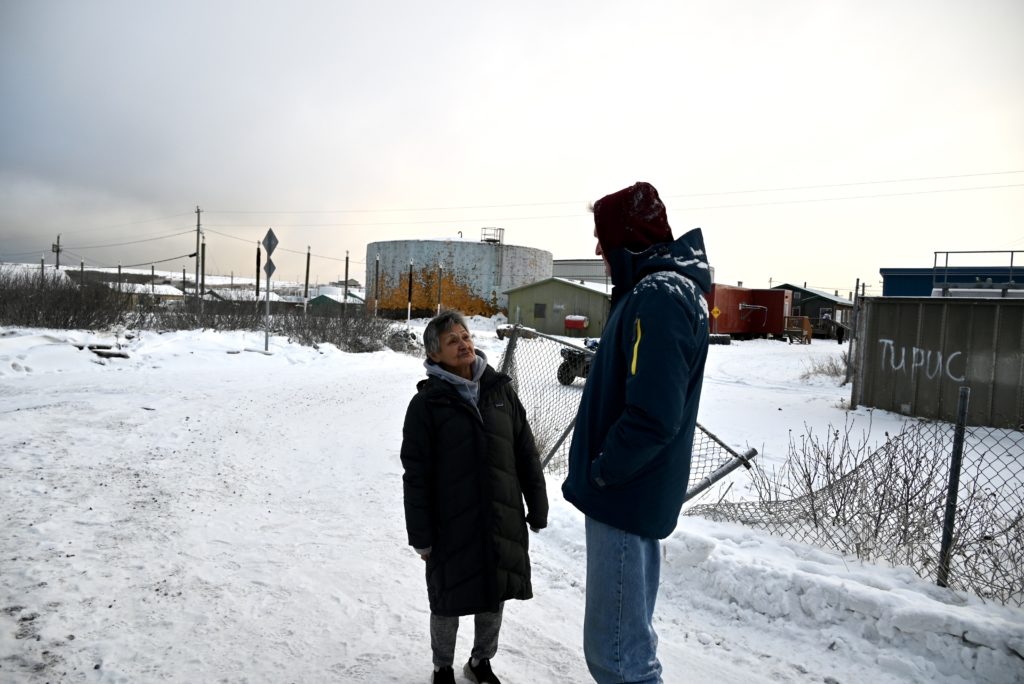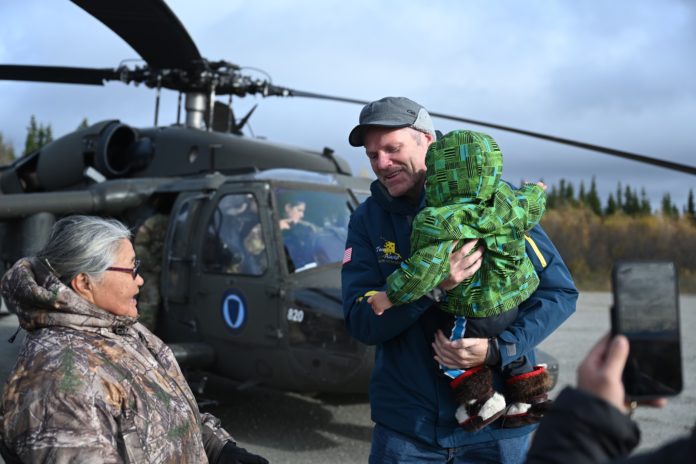There were things that were a lot more important than campaigning this fall for Alaska Gov. Mike Dunleavy.
In mid-September, Dunleavy made a decision, because there was only one right decision for him: The people of Western Alaska needed him to be focused on their major 100-year disaster. He needed to have a steady hand on the wheel, not going to meet-and-greets and fundraisers.
The storm that hit villages on the coast of Alaska on Sept. 17 knocked homes from foundations and peeled apart the breakwaters that protected tiny traditional communities. Typhoon Merbok, with its 50-foot waves in the Bering Sea, put communities like Nome, Stebbins, Hooper Bay, and Koyuk at extreme risk, coming just weeks before winter set in.
Video: Typhoon Merbok remnant hits Western Alaska
Dunleavy, running for his second term, set aside campaigning on the road system, where there are lots of voters to talk to, and during three different trips over more than a month, traveled to the remote western villages of a few hundred people, just to make sure repairs were being coordinated, completed, and that the people were going to be safe this winter.
In many ways, rural Alaska is where Dunleavy is most at home, and for him, it was a travel back through his long life in places that most Alaskans have never seen.
Dunleavy sat down with Must Read Alaska to talk about the way the campaign was changed by the disaster. He first pointed out that today, Nov. 7, is the 35th anniversary of his marriage to Rose, the young woman he met in Noorvik decades ago.
The two married in Nome and raised their family in the Arctic. Rural Alaska runs through his veins and during his first swearing in ceremony, he went to Noorvik and Kotzebue for the historic occasion.
In his trips to the coastal villages this fall, Dunleavy reconnected with many people he knows from the far-flung region — people he taught in school, people who now have children of their own. He got caught up on elders who had passed, and people who have married and settled down. Most of all, he reconnected with the abiding optimism of the people of Alaska, where no matter how full the glass is, “it’s always at least half full,” he said, explaining the hope and sense of community present in the villages that dot the big expanse of Alaska.
As the weather in Western Alaska hovers in the 30s, the rebuild continues. As of last week, FEMA had dispersed over $4.6 million in individual assistance to survivors of the storm, $3.1 million in other needs assistance, which is for essential personal property loss and subsistence gear, and $1.4 million in housing repair funding.




The state Division of Emergency Management continues to purchase building materials and transport them to communities throughout the region, as weather allows air cargo flights to land. Partners are assisting with home repairs, including Native nonprofits like the Association of Village Council Presidents, Kawerak, private contractors through DOT, and the communities. The faith-based and volunteer organizations such as Samaritan’s Purse have all brought in volunteer skilled labor to assist.
Most of the roads that were damaged by the typhoon have been cleaned up, and have temporary or permanent repairs. The same holds true for public buildings that were damaged. Most are usable.
At this point, it appears about $40 million in damage was done to infrastructure throughout the region and some repairs will take years to complete. But community protection structures such as seawalls and berms are either completed or under way, in the event that other storms hit, until the sea and river ice is fastened to the shore.
In addition, approximately 120,425 pounds of food and 220,900 pounds of water have been donated and delivered throughout the area by the State of Alaska, volunteer agencies, regional Native corporations, nonprofits, and health corporations.
All of this is what Dunleavy has been spending his energy and focus on during what has been an anything-but-normal the campaign season, popping back to events on the road system when he is able.
When asked what was one of the most memorable things for him during his trip, he said that landing in Koyuk and being able to hold a grandchild of one of his former students stands out as particularly moving.
“This is the next generation for Koyuk, and the next generation for Alaska,” Dunleavy said. He also remembered meeting with the mayors of the villages, and said that for so many of them, they expressed how resourceful their local people are, and how resilient they are, but how grateful they are for the State of Alaska’s assistance.
“If people have never lived in rural Alaska, it’s hard to describe it. It’s the heart of Alaska, it’s what makes us so different. Without rural Alaska, we’d still be a different kind of place, but it’s rural Alaska that makes us truly unique,” he said.

DUNLEAVY … A good Leader & Governor.
The best choice for Alaska in 2022.
He’s right. Without rural Alaska, the rest would just be another Seattle or Portland. Many will sadly never know the difference.
Not a fan of his, but he did well. In this one instance he was the governor Alaska hoped he’d be.
So, if you’re not a fan of Dunleavy, who is your favorite hero? Walker? You need to take your mask off. It’s blinding your vision.
Am I supposed to take you, or this comment, seriously?
Yes
Then you’re gonna be disappointed. You offer nothing of substance.
Paint drying has more intellectual input.
He has my vote.. Until the Dominion machines switch it
Trump just endorsed him live on stage in Ohio
We will be pulling hard for you and praying for your victory on Tuesday, Governor Dunleavy. God bless you for what you do.
Thank you, Suzanne, for this article. The press did everything it could to hide what the governor was doing. Somehow, he seems to shine best when the going really gets tough. Hopefully, Alaskans will re-elect Big Mike tomorrow instead of the elitist Bill Walker, or Les Gara. As far as Trump goes, he will not endorse a sitting governor that he does not believe in, and he spent a lot of time with Dunleavy. Trump is a hard-nosed businessman, so this endorsement of Dunleavy comes from someone who knows what management is. I conducted my own assessment before deciding to really put him under a concentrated study. It has been quite rewarding and fascinating. It’s amazing how your thinking changes when you finish a Bachelor of Science in Business Administration, even after retirement. Even as I demanded more administrative ability, the concern for people still is a paramount concern. Dunleavy passes that with flying colors. Go to the poles, Alaskans, and please, please Rank the Red, especially in the governor’s race.
Anyone alive today is a composite of his/her ancestors. Please Alaskans never malign the children by maligning their ancestors.
Did anyone else receive a letter from Dunleavy stating you and neighbors voting record?
Disasters somehow work out great for Governors who diss the Federal government 24/6 and on Sundays ask the Feds for disaster relief
Natural disasters are just that, events nobody has control over and our compassion dictates we help those affected. The federal government is set up to assist in these situations, regardless of who needs help.
Besides a governor’s job is to defend the integrity of the state against encroachment from the Feds. In recent years federal entities have attempted to expand their authority and seem to wish to erase state lines and nullify state laws, thereby changing the constitutional character of this country to homogeneous real estate, controlled directly by DC.
Exactly how do disasters work out great for anyone?
Crass, even for you.